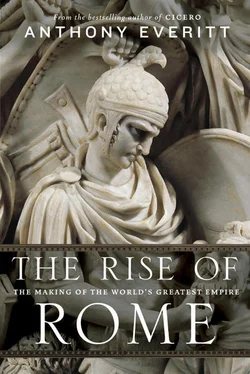The Latins shared a mutual solidarity. Every spring they held a “national” festival, the Feriae Latinae, at which they celebrated their kinship. The central feature was a banquet. Each community brought to the party lambs, cheese, milk, or something similar; a white bull was sacrificed, and its meat was shared among all those attending. The Latin states formed a league from which Rome was excluded, and war soon broke out between them.
Hostilities were not long-lasting. For all the efforts of the Heavenly Twins, the Battle of Lake Regillus was not necessarily the success the Romans claimed it to be. And the opposing forces came to realize that they shared an important interest. They both faced a ring of hostile tribes and communities. Clockwise from the north, there were the Etruscans, especially the rich and powerful city of Veii. Then came the Sabines, the Aequi, the Hernici, and the irrepressible Volsci. Swaths of territory were being lost. Latium was in grave danger of being overrun unless Rome and the Latins reconciled their differences.
In 493, that is what they did. The consul Spurius Cassius (who, as we have seen, was later to be executed for aiming at regnum ) negotiated a peace treaty, the Foedus Cassianum, named after him. Its terms were inscribed on a bronze pillar in the Forum, which was still there in Cicero’s time. At its heart lay a commitment to mutual help:
Let there be peace between the Romans and all the Latin cities as long as the heavens and the earth stay where they are. Let them neither make war upon one another themselves, nor bring in foreign enemies, nor give safe passage to those who shall make war upon either of them. Let them assist one another, when warred upon, with all their forces.
A few years later, the Hernici were brought into the entente. They and the Latins fought in separate contingents under a unified, Roman command. At last, sufficient military force had been assembled to meet the omnipresent threats of invasion from every quarter of the compass.
The background of these small-scale quarrels was a vast movement of peoples from the beginning of the fifth century into Italy and down the peninsula’s Apennine spine. Facing overpopulation and, possibly, pressure from Celts who were beginning to cross the Alps into the Po Valley, Sabellians, mountain dwellers who spoke a language called Oscan, began to migrate southward from their habitat in the central Apennines in search of living space.
The migrations were governed, we are told, by a religious ritual called ver sacrum , the Sacred Spring. A year’s generation of animals and humans was dedicated, or made sacrati , to the god Mars. The animals were sacrificed and the young people, when they had reached the age of twenty or twenty-one, were sent away from their community to look for somewhere else to live. Under a leader they followed an animal, such as a bull, a wolf, or a woodpecker. Where it stopped to rest, there they founded a new settlement or colony.
These bands of young shepherd fighters set off a chain reaction, knocking onto the toe of Italy and threatening the Hellenic cities of Magna Graecia. Oscan-speaking Samnites (a group of Sabellian tribes) flooded down from the hills and invaded fertile Campania. They took over the main cities and set themselves up as a new nation, giving up stock-keeping for farming. The Etruscan ruling class of Capua unwisely let the newcomers in and made them members of the community, only to be butchered en masse after a drunken festival one black night in 423.
For many years Rome only just held its own, much assisted by the Latins, against the Aequi and the Volsci, but in the second half of the fifth century the tide slowly began to turn. A decisive battle against the Aequi was fought on 19 June 431: the fact that the precise date stuck in the Republic’s collective memory suggests how precious the victory was. Lost Latin cities were recovered, and Roman forces at last moved onto the offensive.
IT WAS DURING one of these scrappy campaigns, half skirmish, half full-dress battle, that the story of the staunchly anti-plebeian Lucius Quinctius Cincinnatus is set. This elderly and distinguished patrician and politician had fallen on hard times and farmed a smallholding of four acres. One day, a delegation arrived from the city and found him at work on his land, perhaps digging a ditch or plowing a field. “Is everything all right?” he asked. No, it was not, but the formalities had to be observed. After a prayer for the gods’ blessing on him and his country, he was invited to go and put on his toga, the uniform of the freeborn Roman.
It was no wonder that he was not wearing it, for it was among the most inconvenient garments ever devised by the mind of a tailor. A vast semicircle of heavy cloth, about ten by twenty feet in extent, it was draped over the body and worn without a fastening. Considerable skill was required to stop it from falling off, and it was drafty in winter and stifling in summer.
Cincinnatus returned duly garbed. Only then was he informed of a grave military crisis. A consular legion was besieged in its camp by an Aequian army. Cincinnatus was to serve as dictator and had been commissioned to march to its relief. He quickly accomplished the task. He made a lenient peace with the Aequi, but only after forcing a ritual humiliation on them; a yoke was set up, consisting of three spears under which the entire defeated enemy was obliged to pass, bowing down and so admitting defeat. Mission accomplished, Cincinnatus resigned the dictatorship a fortnight later and returned to his plow.
Although he is not a fully historical figure, Cincinnatus represented a combination of qualities that the Romans greatly admired, even if they were seldom honored in the observance. These were a simple life, commitment to country values, unquestioning patriotism, even-handedness, and disdain for riches. As usual, this admiration found a topographical expression: the old man’s farm, which lay west of the Tiber and opposite the shipyards at the foot of the Palatine Hill, was preserved, at least in name, as the Quinctian Meadows.
As late as the eighteenth century A.D., Cincinnatus was still regarded as a moral model. The American city Cincinnati was so called as a compliment to George Washington, who was considered a latter-day Cincinnatus for his indifference to power. The example has been followed as frequently in recent times as it was in ancient Rome.
SOME TEN OR so miles north of Rome, at the confluence of two small rivers, a large grassy plateau stands on a tall rocky outcrop. Nearly five hundred acres in extent, it has been farming and grazing land for the past two millennia. Closer inspection points to a hidden, long-lost history. In the summertime, aerial or satellite photographs have revealed discolored markings on the fields, the ghostly patterns of lost edifices, and, here and there, ruined walls and the domes of tombs have broken through the earth.
Here once flourished the famous city of Veii, the southernmost outpost of the Etruscan federation (today bordering on the modern village of Isola Farnese). The plateau at the top of precipitous cliffs was probably covered with loosely scattered buildings. In the center, city blocks were arranged in a grid around a central square. Fine chamber-tombs have been excavated in the nearby hills. The city was easy to defend and amply supplied with water; it could sustain a lengthy siege.
Religion was important to the people of Veii. At its southern extremity a high citadel (today’s Piazza d’Armi) contained a sanctuary in honor of the Queen of Heaven, Juno. A temple complex was built in a cutting on the western side of the Veii hill, where a wonderful terra-cotta statue of Apollo, or Apulu, in Etruscan, was discovered in the early twentieth century. The god, a little more than life size, sports a tunic and a short cloak. His hair is tightly plaited on the head and ends in what look very much like dreadlocks. He smiles the mysterious formal smile, each end of his lips pointing upward, of an archaic Greek statue. He was almost certainly made by the most famous of Etruscan sculptors, Vulca, whom the Tarquins commissioned to decorate the Temple of Jupiter on Rome’s Capitol.
Читать дальше








